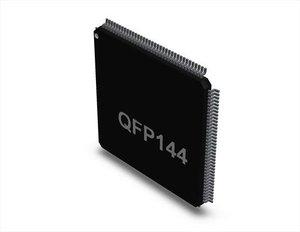
Altera Corporation
EP1K50TI144-3
EP1K50TI144-3 ECAD Model
EP1K50TI144-3 Attributes
| Type | Description | Select |
|---|---|---|
| Rohs Code | No | |
| Part Life Cycle Code | Obsolete | |
| Supply Voltage-Nom | 2.5 V | |
| Propagation Delay | 12.5 ns | |
| Number of Inputs | 102 | |
| Number of Outputs | 102 | |
| Number of Logic Cells | 2880 | |
| Number of Dedicated Inputs | 6 | |
| Number of I/O Lines | 102 | |
| Programmable Logic Type | LOADABLE PLD | |
| Temperature Grade | INDUSTRIAL | |
| Package Shape | SQUARE | |
| Technology | CMOS | |
| Organization | 6 DEDICATED INPUTS, 102 I/O | |
| Output Function | REGISTERED | |
| Power Supplies | 2.5,2.5/3.3 V | |
| Supply Voltage-Max | 2.625 V | |
| Supply Voltage-Min | 2.375 V | |
| JESD-30 Code | S-PQFP-G144 | |
| Qualification Status | Not Qualified | |
| JESD-609 Code | e0 | |
| Moisture Sensitivity Level | 3 | |
| Operating Temperature-Max | 85 °C | |
| Operating Temperature-Min | -40 °C | |
| Peak Reflow Temperature (Cel) | 220 | |
| Number of Terminals | 144 | |
| Package Body Material | PLASTIC/EPOXY | |
| Package Code | LFQFP | |
| Package Equivalence Code | QFP144,.87SQ,20 | |
| Package Shape | SQUARE | |
| Package Style | FLATPACK, LOW PROFILE, FINE PITCH | |
| Surface Mount | YES | |
| Terminal Finish | TIN LEAD | |
| Terminal Form | GULL WING | |
| Terminal Pitch | 500 µm | |
| Terminal Position | QUAD | |
| Width | 20 mm | |
| Length | 20 mm | |
| Seated Height-Max | 1.6 mm | |
| Ihs Manufacturer | ALTERA CORP | |
| Part Package Code | QFP | |
| Package Description | LFQFP, QFP144,.87SQ,20 | |
| Pin Count | 144 | |
| Reach Compliance Code | compliant | |
| HTS Code | 8542.39.00.01 |
EP1K50TI144-3 Datasheet Download
EP1K50TI144-3 Overview
The chip model EP1K50TI144-3 is a highly advanced integrated circuit that has the potential to revolutionize the way networks and intelligent systems are developed and implemented. This model is an FPGA (Field-Programmable Gate Array) which is a type of integrated circuit that can be programmed to perform various tasks. It is designed to be used in a wide range of applications, from basic logic circuits to more complex tasks such as artificial intelligence (AI) and machine learning.
The EP1K50TI144-3 is a high-performance, low-power, and cost-effective FPGA that is suitable for a variety of applications. It is capable of providing up to 144K logic elements, which can be used to implement complex functions such as neural networks, image recognition, and natural language processing. It also supports a high-speed serial interface and can be used in a variety of systems such as digital signal processing, embedded systems, and telecommunications.
This chip model can be used to develop and popularize future intelligent robots. It can be used to build robots that are capable of performing complex tasks that require a high degree of intelligence. For example, it can be used to develop robots that can recognize facial expressions, interpret spoken language, and even interact with humans. To use the EP1K50TI144-3 effectively, a range of technical skills are needed, such as programming, circuit design, and system design.
Case studies of the EP1K50TI144-3 have demonstrated its potential to revolutionize the way networks and intelligent systems are developed and implemented. For example, it has been used in the development of autonomous vehicles that can detect and respond to their environment. It has also been used in robotic arms that can perform complex tasks such as picking up and placing objects.
When using the EP1K50TI144-3, it is important to consider the design requirements of the application in order to ensure that the chip is used effectively. For example, when using the chip in robotics applications, it is important to consider the power requirements, the speed of the processor, and the memory requirements. Additionally, the temperature and humidity of the environment should be taken into account in order to ensure that the chip functions correctly.
In conclusion, the chip model EP1K50TI144-3 is a highly advanced integrated circuit that has the potential to revolutionize the way networks and intelligent systems are developed and implemented. It can be used to develop and popularize future intelligent robots, and a range of technical skills are needed to use the model effectively. Case studies have demonstrated its potential to revolutionize the way networks and intelligent systems are developed and implemented, and when using the EP1K50TI144-3, it is important to consider the design requirements of the application in order to ensure that the chip is used effectively.
You May Also Be Interested In
5,863 In Stock
Pricing (USD)
| QTY | Unit Price | Ext Price |
|---|---|---|
| No reference price found. | ||
